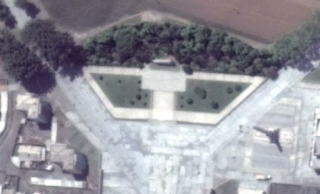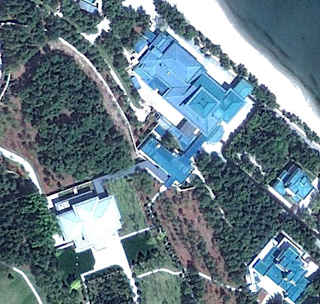With
Phase I having been published around 6 months ago and the recent mid-range
ballistic missile test on Sept. 5, I figured I should give an update on where Phase II stands.
I'd like to quickly touch on the missile tests. According to CNN, the tests were carried out in Hwangju County, North Hwanghae Province (25 miles south of Pyongyang center). Korean Central Television released a YouTube
video of the missiles being fired. In the video, you can see that the missiles were fired from mobile launchers positioned on a major highway with a highway tunnel in the background. In another scene a cell or radio tower is also visible.
Given the positioning of the camera, it's difficult to really gauge how far away the tunnel is from the launchers, however you can see a "turn around" spot near the tunnel and a bit farther back toward the launchers, you can see a section of pavement that looks a bit darker than the rest. This is typical of bridges. There's only one highway section that features all of these things near Hwangju.
So, this stretch of highway would seem to be the most likely location of the tests. Hwangju is also the home of the Third Air Combat Command which is responsible for the defense of the DMZ and southern portions of the country, which means they would have access to ballistic missiles. Additionally (whether or not these missiles came from here), the hills around Hwangju are filled with tunnels, hardened artillery sites, military units, and military storage facilities. That said, I cant't find any section of highway in the entire province that seems to look
exactly like the video footage.
Mapping Update
As I mentioned in the Phase I
release post, Phase II (which I'm working on now) will include a map of all the schools, town halls, "Palace's of Culture" (Juche study halls), and other buildings of interest in the country. I started mapping these places part-way into Phase I, meaning that I had to go over the rest of the country another time to get all the sites I hadn't originally marked.
The blue dots cover all the areas I have had to
re-map (which adds up to roughly half of the country). In addition, I decided to go over Pyongyang entirely for a second time because of how dense the city is. My goal in all of this is to not miss greater than 10% of any given type of item (cell towers, schools etc) nationwide.
The Google Earth file size for
Phase I is 2.7 MB and contains over 28,000 places. The current Phase II file adds a further megabyte, and I'm not even finished working on it! The file for Pyongyang itself has nearly doubled in size.
To help make the project of greater use to people, I have been scouring different sources for additional information on the various sites I've marked. If the name of a school is known, I want that placemark to be given the school's name. If a fancy looking new building pops up, I want to be able to tell you what it is, and so forth. Since I began this project over 3 years ago, I have also gone back through some of the folders and updated them, better categorized some places (particularly military sites), and worked to make everything uniform in terms of descriptions and the icons used.
The work for Phase II really comprises two parts: the first part is all the new mapping I'm doing, the second part is taking Curtis Melvin's
North Korea Uncovered file (which is now over 7 years old) and updating any changes that have happened to the 8,100 sites he mapped. This also includes making corrections to places that were incorrectly identified (there aren't many, but accuracy is important) as well as fixing a problem created by Google Earth itself.
When Google Earth has updated imagery added, sometimes the coordinates don't mesh perfectly and, particularly in South Hwanghae Province, around 2006 the coordinate system was adjusted. The practical meaning is that many of the places marked there by Curtis are now off by as much as 1,000 feet. So I need to go through all of them and move them to their "corrected" positions. Oh, and I have to do the same for the large military-focused
file created by Google Earth user "Planeman_" and then collate his and Melvin's files because each project, while largely covering the same places, did map out some spots the other person missed. All of this adds up to a mountain of work.

The work of Phase I was completed in Nov. 2015 and released in March 2016. Since then, I have been able to go over nearly all the places I needed to. I only have about 20% of Pyongyang left. I have also already gone through thousands of sites marked by Melvin and Planeman_, though there is still much work remaining on that front. Some of the cool things that my comprehensive map will be able to bring to the general public is: 24 surface-to-air missile sites previously un-mapped by the earlier projects, the entire network of cell towers (very few existed during the time Melvin was working on his project), an updated map of their missile testing sites, more detailed maps of various palaces, a much more detailed map of Pyongyang with hundreds of buildings marked, and lots of added bits of information on countless other sites (including nuclear facilities).
I have a two week international vacation coming up soon and then of course the holidays are getting closer and closer, but I am really hoping to be able to have my Phase II mapping completed, the corrections/updates made to North Korea Uncovered, and the combining of Phase II, NKU, and Planeman_'s projects into a single master file with no duplicates and as few holes as possible by the end of 2016, if not sooner.
I'd like to thank everyone for their continuing support and patience. This has turned into a major project that has required thousands of hours of work and research. I hope it will be useful and live up to expectations once completed.
--Jacob Bogle, 9/7/2016
www.JacobBogle.com
Facebook.com/JacobBogle
Twitter.com/JacobBogle


















